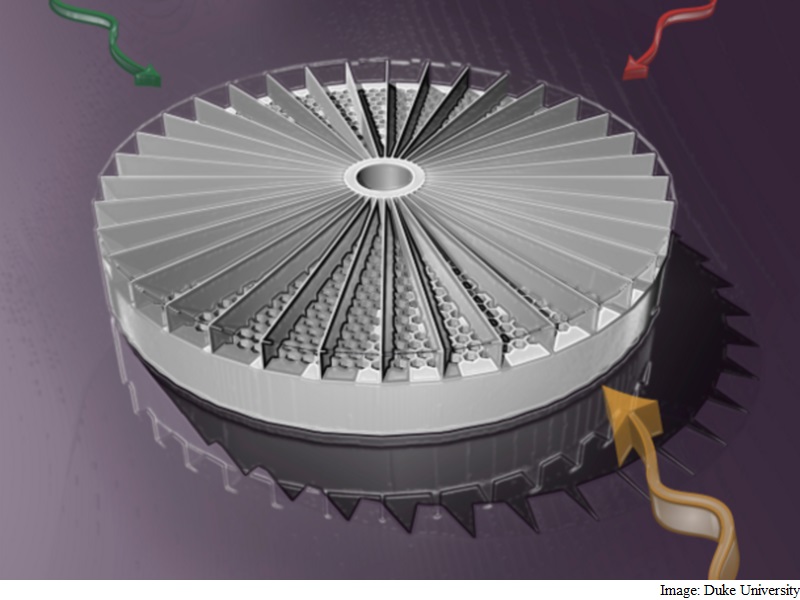- Home
- Mobiles
- Mobiles News
- New Sensor to Help Smartphones Hear Through 'Cocktail Party'
New Sensor to Help Smartphones Hear Through 'Cocktail Party'

"We've invented a sensing system that can efficiently solve an interesting problem that modern technology has to deal with on a daily basis," said the paper's lead author Abel Xie.
"This could improve the performance of voice-activated devices like smartphones and game consoles," Xie added.
The sensor developed by Duke engineers can determine the direction of a sound and extract it from the surrounding background noise.
Once miniaturised, the device could have applications in voice-command electronics, medical sensing devices that use waves, like ultrasound, and hearing aids and cochlear implants.
The proof-of-concept device looks a bit like a thick, plastic, pie-shaped honeycomb split into dozens of slices. While the honeycomb openings may all look the same, their depth varies from hole to hole.
"The cavities behave like soda bottles when you blow across their tops. The depth of the cavities affects the pitch of the sound they make, and this changes the incoming sound in a subtle but detectable way," said Steve Cummer, professor of electrical and computer engineering at Duke.
When a sound wave gets to the device, it gets slightly distorted by the cavities. And that distortion has a specific signature depending what slice of the pie it passed over.
After being picked up by a microphone on the other side, the sound is transmitted to a computer that is able to separate the jumble of noises based on these unique distortions.
The researchers tested their invention in multiple trials by simultaneously sending three identical sounds at the sensor from three different directions.
It was able to distinguish between them with a 96.7 percent accuracy rate.
The findings were described in the Proceedings of the National Academy of Sciences.
Catch the latest from the Consumer Electronics Show on Gadgets 360, at our CES 2026 hub.
Related Stories
- Samsung Galaxy Unpacked 2025
- ChatGPT
- Redmi Note 14 Pro+
- iPhone 16
- Apple Vision Pro
- Oneplus 12
- OnePlus Nord CE 3 Lite 5G
- iPhone 13
- Xiaomi 14 Pro
- Oppo Find N3
- Tecno Spark Go (2023)
- Realme V30
- Best Phones Under 25000
- Samsung Galaxy S24 Series
- Cryptocurrency
- iQoo 12
- Samsung Galaxy S24 Ultra
- Giottus
- Samsung Galaxy Z Flip 5
- Apple 'Scary Fast'
- Housefull 5
- GoPro Hero 12 Black Review
- Invincible Season 2
- JioGlass
- HD Ready TV
- Laptop Under 50000
- Smartwatch Under 10000
- Latest Mobile Phones
- Compare Phones
- Red Magic 11 Air
- Honor Magic 8 RSR Porsche Design
- Honor Magic 8 Pro Air
- Infinix Note Edge
- Lava Blaze Duo 3
- Tecno Spark Go 3
- iQOO Z11 Turbo
- OPPO A6c
- Lenovo Yoga Slim 7x (2025)
- Lenovo Yoga Slim 7a
- Lenovo Idea Tab Plus
- Realme Pad 3
- Moto Watch
- Garmin Quatix 8 Pro
- Haier H5E Series
- Acerpure Nitro Z Series 100-inch QLED TV
- Asus ROG Ally
- Nintendo Switch Lite
- Haier 1.6 Ton 5 Star Inverter Split AC (HSU19G-MZAID5BN-INV)
- Haier 1.6 Ton 5 Star Inverter Split AC (HSU19G-MZAIM5BN-INV)







![[Sponsored] Haier C90 OLED TV | Dolby Vision IQ, 144Hz OLED and Google TV in Action](https://www.gadgets360.com/static/mobile/images/spacer.png)









